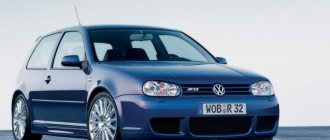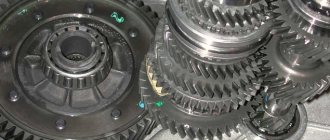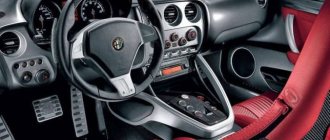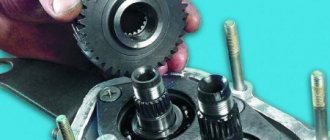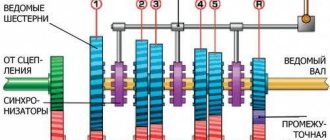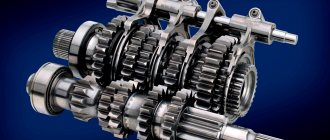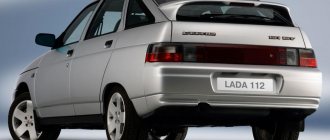The modern automobile market is diverse and multifaceted. All cars have long begun to differ not only in the type of engine and clutch, but also in the design of the transmission. The most common is the manual transmission, but the automatic transmission closely competes with it.
You can hear various arguments from car enthusiasts about which gearbox is better, what are the advantages and disadvantages of each of them. But what if you create an ideal symbiosis of two checkpoints? Take the best from “mechanics” and “automatic” and create a car with a perfect transmission. Until recently, this was considered unrealistic.
The history of the dual-clutch transmission
The first thoughts about how to create a continuous connection between a car engine and transmission came to Adolf Kegress back in 1939. But due to lack of funds, the invention was not translated into reality, but remained on paper. With the development of motorsport, when a racing car needs to quickly change gears without losing power and connection with the wheels, engineers at German automakers had to dig up their archives. Find and improve the Kegress development.
The dual-clutch transmission experienced its baptism of fire at the famous Monza race. The Porsche 962 equipped with this gearbox left no chance for its competitors. The time to switch gears took tenths of a second. And this without loss of power.
"Wet" double
There are two types of clutch, dry and wet (also multi-plate in oil). The so-called “wet” has better cooling. Most often it is installed on gearboxes with a torque of 250 Nm and above. An example would be the Bugatti Veyron, whose torque reaches 1250 Nm.
The second set of discs is mounted on separate hubs, which are located on the input shaft of the corresponding row of gears. In the normal position the mechanism will be open. As for the closure, this is done thanks to hydraulic cylinders controlled by an electrohydraulic module. The disks take their initial position due to springs.
Box device
If you disassemble this gearbox and look at its structure, you will immediately notice that the dual-clutch gearbox consists of two classic “mechanics”. The double shaft is the main working body of the device. Actually, why is the gearbox called double clutch? This is because in it one clutch transmits torque to the first (external) shaft, and the second transmits energy to the internal shaft. The outer shaft is responsible for even gears, and the inner one for odd ones. But there is no clutch pedal, and the mechanism is controlled electronically and hydraulically, as in an automatic transmission.
All this allows you to change gears comfortably and smoothly, without jerks or difficulties. There is no loss of power and continuous communication with the engine is ensured. There are some similarities with an automatic transmission, but the dual clutch operates without a torque converter. All the painstaking work is performed by a “wet” multi-disc mechanism.
Varieties of DSG
Currently, there are two types of DSG gearbox:
- six-speed;
- seven-speed.
General diagram of 6 and 7-speed DSG
Initially, the preselective automatic transmission was six-speed. It uses a wet-type double clutch (in everyday life – “wet”). The clutch is constantly in oil, which provides lubrication of the parts and cooling of the discs, which, in turn, increases its service life.
Unlike the six-speed gearbox, the clutch of the 7-speed DSG is “dry”, and this automatic transmission requires three times less oil. The hydraulically driven oil pump has been replaced here with an electric one, which reduces energy consumption and increases the fuel efficiency of the engine. But the clutch resource will be lower.
DSG 6 transmission
The DSG 6 automatic transmission is not the latest model in a series of robotic transmissions from Volkswagen. But it is considered more powerful - the engine torque is 350 Nm.
Today this gearbox is installed on cars of the following brands:
- Volkswagen (Golf, Passat, Jetta, Touran, Tiguan);
- Skoda (Superb, Octavia);
- Audi (A3, Q3, TT);
- Seat (Toledo, Alhambra).
Transmission DSG 7
The seventh DSG model appeared three years after the sixth and was made specifically for budget cars. DSG 6 is distinguished by its large weight (about 95 kilograms) and a large volume of gear oil. DSG 7 weighs about 70 kilograms and has a smaller oil volume, which has a positive effect on fuel consumption and the cost of regular maintenance.
7-speed DSG device
DSG 7 is installed on cars equipped with an engine with a torque of up to 250 Nm. These include the following models:
- Volkswagen (Golf, Passat, Transporter, Caddy);
- Skoda (Fabia, Superb, Octavia);
- Audi (A3, Q3, TT);
- Seat (Ibiza, Leon, Altea).
The design of a “dry” DSG is no different from a “wet” one. It is based on: the first and second secondary shafts, the main gear, the oil filter, the flywheel and the Mechatronics unit. A special feature of this automatic transmission is the presence of two dry friction clutches that do not operate in an oil bath. This technical innovation made it possible to significantly increase the efficiency of the box.
Operating principle of the gearbox
Switching speeds is carried out by intuitively determining various factors electronically, namely:
- The position of the accelerator is determined. Based on this, the electronics concludes that acceleration or braking is occurring;
- The speed of rotation of the car wheels is determined;
- Number of revolutions of transmission shafts.
All this can be explained as follows: as soon as the car starts moving in first gear, the system prepares the next one. The first clutch opens, which forces the second to close. There is a moment in the operation of the gearbox when both mechanisms are in a closed position, but this only takes hundredths of a second. During this time, there is no loss of torque.
The video shows the operating principle of a double clutch transmission (DSG):
This creates a dynamically ideal vehicle movement. The most popular dual-clutch transmission today is considered to be a device from BorgWarner. The company works closely with the automotive giant Volkswagen. Prestigious cars are equipped with this type of dual-clutch gearbox. The development from Getrag is considered the most environmentally friendly; their transmissions contribute to the emission of a tiny amount of carbon dioxide into the atmosphere.
Graphic diagrams of wet and dry clutches
Wet double clutch diagram:
- Input hub;
- Clutch hub first;
- Clutch hub second;
- Leading disk;
- Clutch disc pack second;
- First clutch disc pack;
- Diaphragm spring;
- Piston;
- Hydraulic cylinder of the first clutch;
- Primary shaft for row 1;
- Primary shaft for row 2;
- Main hub;
- Piston;
- Coil spring;
- Second clutch hydraulic cylinder.
Dry double clutch diagram:
- input shaft 1;
- release bearing 2;
- diaphragm spring 2;
- pressure plate one;
- master disk;
- dual-mass flywheel;
- clutch disc 2;
- pressure plate 2;
- clutch disc 1;
- diaphragm spring 1;
- release bearing 1;
- input shaft 2.
Video of how the S-Tronic system works on Audi:
Source of the article: https://fastmb.ru/auto_shem/1038-dvoynoe-sceplenie-opisanie-i-princip-raboty.html
Advantages and disadvantages
According to many automotive experts, cars equipped with dual-clutch transmissions will soon reach a new level and take a strong position in the market. Since such transmissions differ:
- Smooth running, dynamic, constant connection with the engine;
- Increased fuel economy;
- Gear shifting in two modes: manual or automatic;
- There is no need for re-gasping or double squeezing.
All these advantages have become a viable solution to many problems for racing cars, where the cost of time is too high. But for public vehicles, in addition to the advantages, such a gear shift device will bring some difficulties for the owner, due to:
- Complexity of the mechanism;
- Expensive maintenance and repairs;
- Lack of specialized services.
The mechanism is very complex in its design. In addition, the gearbox has not become widespread in Russia, therefore, finding an understanding specialist today who could carry out high-quality repairs of the mechanism is very difficult. But in the future, most likely, the situation will change dramatically.
The bigger, the better
A modern “robot” with two clutches shows excellent results in terms of shift speed, but its spread is primarily due to reduced fuel consumption. According to the VW concern, using the example of a Golf with a 122-horsepower TSI engine, the version with DSG consumes on average 8.7% less gasoline than a similar one with a conventional “mechanics”. And compared to a hydromechanical “automatic machine,” the “robot’s” gain reaches an impressive 22%. Reducing fuel consumption means increasing environmental performance - the less fuel a car burns, the less carbon dioxide and toxic substances it emits. Improving the environmental friendliness of a car is a very fashionable topic now, and one of the ways to achieve success in this direction is to increase the number of steps. This trend has not bypassed dual-clutch transmissions. Seven gears is no longer considered “a lot”. While VW decided that there was no point in developing a 10-speed DSG, Acura still created a nine-speed one for the NSX sports coupe. Moreover, Honda has patented an 11-speed gearbox with three (!) clutches, probably hoping to achieve super-green performance in the future.
Sharp starts and low flights
“Racers” who practice starting with two pedals on a civilian car should remember that there is a protective mechanism that prevents the clutch disc from closing with the flywheel. The turnover simply will not grow. If such protection is not provided, then the discs will close, but they will slip, since the brake pedal will not allow the car to move.
Servicemen also warn about the negative impact of driving with frequent acceleration and braking - the gearbox control may not keep up with the frequent changes in the mood of the driver, who abruptly and alternately presses the accelerator and brake pedals. If you decide to indulge in aggressive aerobatics, then choose manual mode.
Mitsubishi
Here the prices are no longer the same as in previous cases. For example, for a Mitsubishi Lancer, the LuK 620316900 clutch kit costs 14-15 thousand rubles, and LuK 623356809 is already 43-44 thousand. There is also a cheaper option - the KraftTech W20200F set for the same model costs from 5-6 thousand rubles. (bearing, basket and disc). The cost of clutch repair work, which includes removal/installation and cleaning, is 8-9 thousand rubles. If you take the clutch as a kit from LuK, the repair cost can be 53 thousand rubles. and more. If you do not need a set, but some individual parts, the amount may be reduced - it all depends on the manufacturer.
Clutch kit LuK 620316900 for Mitsubishi Lancer. Average price: 14622 rub. Photo: YandexMarket.
BMW
A clutch kit from LuK for models 320i (factory index E36), 520i (E34) will cost 24-25 thousand rubles. If you only need to change the clutch disc, an inexpensive option for BMW 5, 6 and 7 series is offered by Sachs - 7.5-8 thousand rubles. A set from Edel Racing, which includes a pair of sintered metal-ceramic discs with a diameter of 215 mm, will cost 53-54 thousand rubles. However, the original complete double clutch kit costs from 107 thousand rubles. and higher. For example, GS7D36SG wheels from Even cost 129 thousand rubles. Work to replace the clutch assembly will cost 8.5-9.5 thousand rubles.
Replacing the clutch on a BMW E46. Photo: Youtube. com.
As you can see, the cost of repairs for different brands of cars greatly depends on the number of parts purchased and their manufacturer. The cost of replacing a double clutch is approximately the same - from 8 to 9 thousand rubles. The exception is “Ford” - up to 15 thousand rubles.
Features of ceramic clutch
The life of the clutch and the efficiency of its operation at the load limit also depend on the properties of the material that ensures the engagement of the discs. The standard composition of clutch disc linings on most vehicles includes a compressed mixture of glass and metal fibers, resin and rubber. Since the principle of operation of the clutch is based on friction, the friction linings of the driven disc are designed to operate at high temperatures, reaching up to 300-400 degrees Celsius.
Clutch disc with ceramic friction linings
In high-performance sports cars, clutch loads are much higher than normal. Some transmissions may use ceramic or cermet clutches. The material of such overlays includes ceramics and Kevlar. Metal-ceramic friction material is less susceptible to wear and can withstand heating up to 600 degrees without loss of performance.
Manufacturers use various clutch designs that are optimal for a particular vehicle, based on its purpose and cost. The dry single-plate clutch remains a fairly effective and inexpensive design to manufacture. This scheme is widely used on passenger cars of the budget and middle classes, as well as SUVs and trucks.
Take your time when switching
Switching the lever between the main modes “parking” and “drive” should occur while the car is stationary with the brake pedal fully depressed. You should start driving after the gear is fully engaged.
It is not recommended to pull the DSG selector while changing modes - everything should be done not hastily, but smoothly, since the electronics of the box need 1-2 seconds to understand what they want from it. There is information that such a simple method is enough to increase the resource of the unit.
